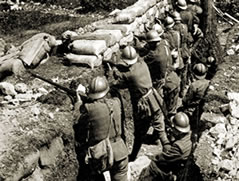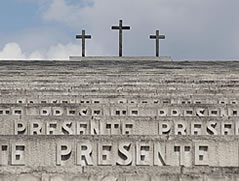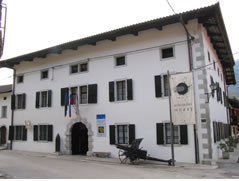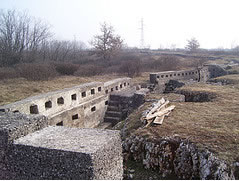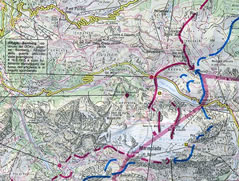
The places of the Great War
The First World War was one of the bloodiest wars that mankind can remember and since May 23, 1915 Italy declared war on Austria-Hungary, it was to create the so-called Italian-Austrian front that covered over 600 kilometers Ortler to the Adriatic.
Two thirds of this front was deployed just north-east of Friuli in the extreme, between Italy, Austria and Slovenia, coming up to the Carso near Monfalcone.
It was about 5 million Italians who fought this war, defined position, living in close contact with other soldiers inside the infamous trenches that were the sad protagonists of those years. Places where the soldiers had to suffer for months and years the fears of a never certain but death always lurking where the living conditions were at the limit of human endurance: corpses, rats and epidemics were the "companions" newspapers these men, tormented also from the merciless climatic conditions especially in winter.
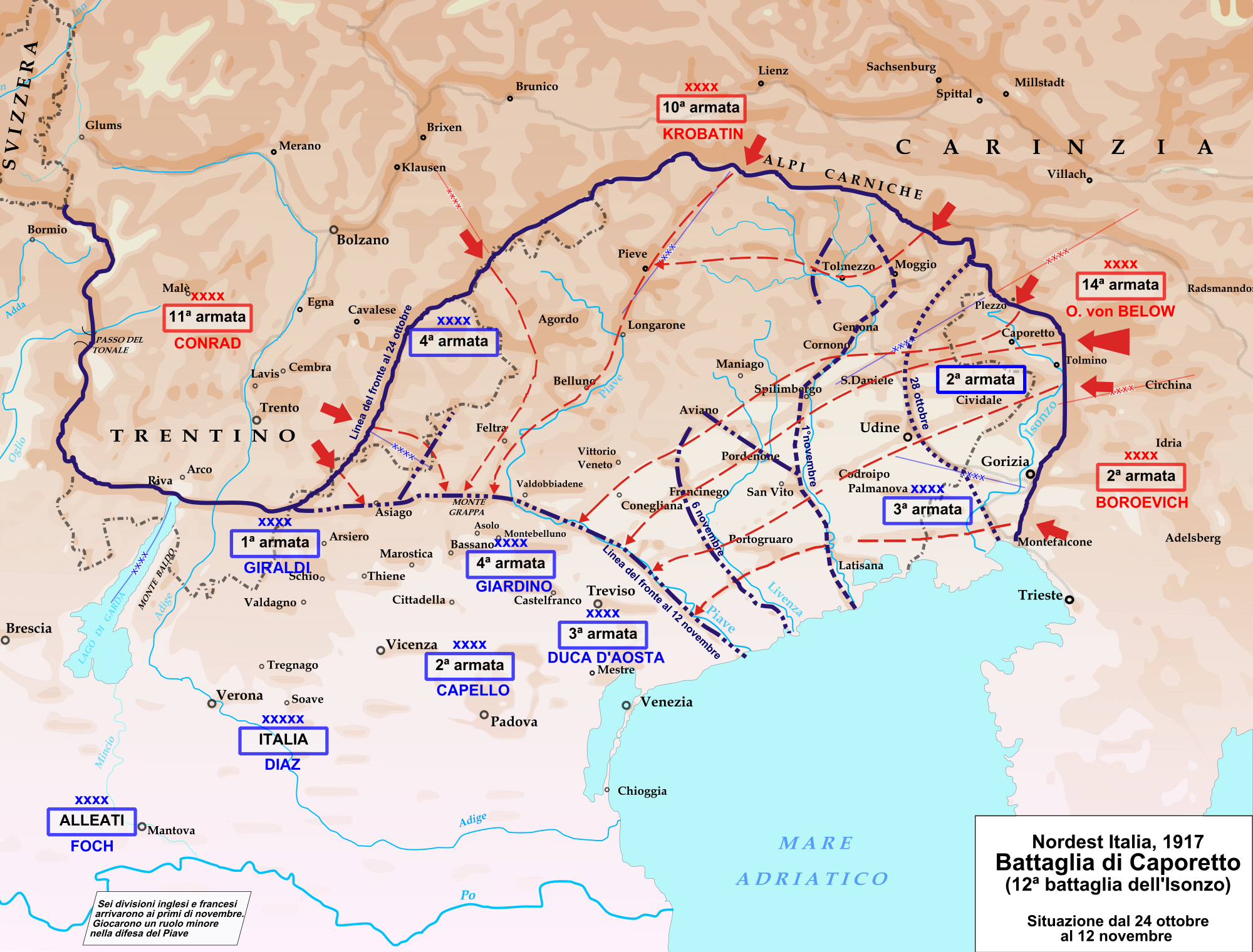
But what were these trenches and what it meant to live in it with the knowledge that sooner or later would come an enemy attack, an artillery attack or the dreaded poison gas?
One way to get an idea of what it meant to live in those conditions is to go directly to the sites of major battles and see with their own eyes what has been preserved from that period exploring fortifications, churches, cemeteries and trenches that despite the passage of time have remained virtually intact to this day bearing witness to a conflict that would mark us forever until the outbreak of World war II.
A voyage which follows roughly the Soca River, showing all the places where Italian and Austrian faced each other in the forefront even a few tens of meters away from each other within their own trenches.
From Bovec, known for the barbaric use of toxic gas by the Central Powers in Kobarid, via Monte Nero (Krn), of Kolovrat the chain and heading south between Tolmino and Gorizia coming up to the karst areas of Monfalcone, you can discover a world full of history where daring assaults and bloody clashes culminated in the famous Caporetto a few kilomentri by the current Italian border.
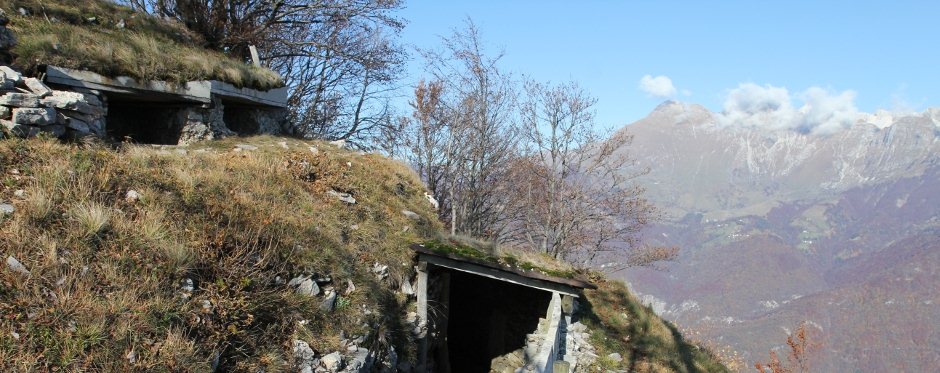
Monte Nero, famous for taking on the part of the Alpine Exiles battalion on the night between 15 and 16 June 1915, is the highest mountain system in Bovec, Tolmin and Kobarid.
Just won on the north several galleries were excavated to make room for artillery pieces that would bomb the nearby Batognica (Red Mountain) defense by the Austrians.
Mrzli Vrh: Elevation not great (1359 meters), but extremely steep and cut by deep ravines, Mrzli Vrh is the focus of Sleme and Vodil forming a long, steep ridge above the Tolminka Valley, at the time the main supply route Austro-Hungarian industry. its possession would have guaranteed them Italians two advantages: eliminating the logistical support to the front at the top and down the back of the flat Tolmin negating the barrier function of the two cornerstones of Mengore (Santa Maria) and Selski Vrh (Saint Lucia) that they formed a mail bridgehead to the closure of the Idrijca valley and the hypothetical route of penetration toward Ljubljana.
In a few lines the corresponding Viennese War Alice Schalek effectively describes the disturbing fame that in just over a year of the war had won that hump mangy to sull'Isonzo peak.
".. It 'even worse than on the Monte San Michele, because beyond the line of fire not above it. And it's worse than the Podgora, because this mountain so tormented by fourteen months has only two hundred meters high. And' worse than in the area Plava - Zagora, because there the line is not so terribly long. of these four points of scary Soška Mrzli Vrh is probably the most horrendous - a dubious distinction of which those who are on the mountain indicted would rather avoid ... ".
Mrzli, Merzli, Mrzlwrick, Scallop, mangled name in the news, evoked almost as a curse, became synonymous with impossible position, so as to throw into even experienced officers discomfort, like a captain of the Salerno brigade, before returning online loses control and in front of his men:
"... Screams of a sudden, red and congested like a madman: I will not be there on Scallop, I do not want to die without purpose without get yourself anything, because they do not take Scallop: son six months that we are to beat and beat on this iron nail and death. Later we do not go: the summit will not seize. "
(Text taken from the book: "From Tolmin to Kobarid along the paths of the Great War between Italy and Slovenia" Marco Mantini)
Bovec (Bovec), a few kilometers north of Caporetto, is infamous for being a witness to one of the first battles where you face use of poison gas. The Austrians in October 1917 fired their bullets in the basins which killed around 800 Italian soldiers, dying as affected by an invisible fist. This attack was the beginning of a series of offensives that will lay the foundation for the infamous Caporetto that would take place the same month a few days later.
Caporetto: The October 24 of 1917 in fact, at 02:30 the Austro-German guns began to pour into the valley of the fire and a gas inferno in a matter of hours caused a collapse in the right wing of the 2nd Italian Army . After about a million people, virtually the entire eastern front, began to back toward the first tower, then to the Tagliamento and finally towards the Livenza. The 3rd Army remained on the Carso followed suit the next day to avoid being encircled by the force of the Austro-Hungarian Empire and reached the Piave November 6.
On 7 November the King destituiva Luigi Cadorna from Italian Commander in Chief of the Army; in his place he was appointed General Armando Diaz.
November 10, ended the Italian retreat: it had cost 10,000 dead, 30,000 wounded, 300,000 prisoners, 350,000 stragglers and deserters; They were lost 3,152 artillery pieces, 1,732 mortars, 3,000 machine guns.
The Caporetto defeat marked undoubtedly a turning point in how the army and the public were living a state of war and in the supply line of the conflict, which for the first time took on a distinctly defensive character.
Certainly, the will to resist at all costs against the invader was neither as immediate nor as widespread as the propaganda would have us believe mythic post-war: between the military is still alternated for several months the hope and discouragement, and even until the end of 1917 there was no lack widespread phenomena of defeatism on the part of those who were hoping for a defeat that would put an end to war anyway.
A landslide victory
After the breakthrough in Bovec and Tolmino, Twelfth Battle of the Isonzo, the battalion of German mountain of Wurttemberg in whose ranks militated an unknown lieutenant named Erwin Rommel career, was commissioned to act as a vanguard of the Jager Division and reach the Longarone soon as possible, to cut the road to the Cadore troops they were retreating toward the Grappa. Rommel chose the path that was the road built by the Italian Alpine between 1910 and 1912 that linked the Val Cellina to Val Meduna
Fork through Clautana, a path can still be traveled.
Past the Soca October 24, 1917, after three days of battle and conquest of Matajur, the Wurttembergisches Gebirgs Bataillon (WGB) enters in Cividale on 27, thus covering 50 kilometers of mountain road at gunpoint in 3 days. Saturday, October 28 continues the march towards the land of Primulacco, the tower is passed on 29 without clashes. Monday, October 30, cold and rainy day, are achieved Coesano and Villanova, the 31 battalion is on the Tagliamento, where headquarters at rest until 3 November. In those days Rommel, called the German Command in Udine, he receives the order to move the cutting edge of Jager Division, reporting to the greater Sproesser, and to focus on Longarone. At dawn on November 4, the WGB passes the Tagliamento on the Cornino bridge, the direction is Meduno-Chievolis-Claut-Cimolais-Spar. A Alpini Brigade in the rear slows the path, Chievolis, November 6, the first clash: the 5th Alpini groups, Sharpshooters and gunners oppose strong resistance, only finished surrendering ammunition.
That day the WGB captured four officers and 230 soldiers. The Germans then proceeded to Fork Clautana, they had joined a few batteries of mountain howitzers and a battalion of Schutzen; the advance of these troops fast, thanks to the discovery of a large number of folding bicycles bersagliere, which occurred in the plains days before, had left behind the baggage and the battle they had to prepare an empty stomach. Tuesday, November 7, the WGB is under the fork, lined up there are Italian troops. At the center of the fork are the daring of the eighteenth spearhead, left the 34 ° - 35 ° and 36 ° Alpine Company of the battalion Val Susa, right two companies of riflemen, with 6 mountain guns. Are the rearguard troops of the 26th division of Danise Colonel, with the task of holding the enemy for as long as possible. The Germans gather three companies facing up; Rommel and two sections of machine guns are positioned on the slopes of the Col Cavasso, so as to dominate defenses on the side and from above. 19 at the first assault. Italians defend themselves with order, not retreat, while suffering heavy losses from machine guns placed on the Col Cavasso. The Germans not to be better, it is impossible to approach the center, the attack is suspended. From the diary of Lieutenant Rommel:
"I give a little 'rest to my men, and in the meantime I'm going to take a look ... I can find the favorable emplacements for machine guns, just a few hundred meters from the pass ..".
Around midnight the department Rommel again attacked the fork; supported by machine guns, Jager and Schutzen arrive a few meters from the Italian line, there is a lengthy exchange of hand grenades, then back at the attackers are forced to ritirarsi.Ancora from Rommel's diary:
"..I Am annoyed. It 's the first attack since the war that goes to me bad. Hard work hours went up in smoke. A repetition of the action seems hopeless."
Wednesday, November 8, in the pitch dark, a German patrol Salt Fork Clautana to test the Italian resistance and has a surprise: the step is empty, no trace of the defenders who have taken advantage of the night to break away and get off at Longarone. Resumes the chase, the Germans to come in at 14 Claut where a patrol of the 8th Bersaglieri, 2 officers and 30 men, try a resistance immediately won. In Claut people do find some dinner tables and WGB stops to refresh themselves.
Meanwhile, the retreat of the Italian rearguard continues, orders and counter one another, is prepared a new line of resistance just outside Claut by two full battle battalions, withdrawn and sent to guard the pass of San Osvaldo, above Cimolais, the last before Longarone. The evening of 8 of the largest group Sproesser reaches the vanguard of Rommel in Cimolais; also comes an order from the command of Jager Division: the WGB to rest waiting for fresh troops of the 26th Schutzen. But Sproesser does not intend to give up right now, in fact asks for reinforcements. Thursday, November 9, cold and snow that cuts the face, at 5 am the troops on both sides are waiting. Opposite the step St. Oswald still Rommel and its vanguard, while a company tries to circumvent passing on high rocks of the Monte Cornetto: it's a disaster. Fresh snow betrays the attackers who slip into the cliffs and some die. No time to groped another maneuver that is not repeated in the attack Fork Clautana and so is done.
The Italian defense line consists only of two companies of the 10th battalion of Sharpshooters, which is invested by blasts of machine guns on the sides and in front, while the German troops are done under. 9.45, attackers can penetrate and disorganize the defense and capture 4 officers and 120 soldiers, the others retreated to Longarone. Now jump back out bicycles bersagliere that the Germans had left the road and with these threw themselves on the descent from the pass of San Osvaldo leads to Longarone. The bridge over the gorge of Vajont is taken intact. In front of Longarone, lightly sprinkled with snow, swarming with Italian troops in retreat.


